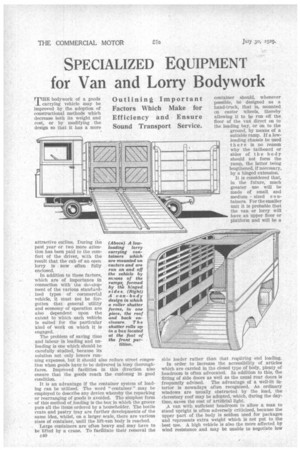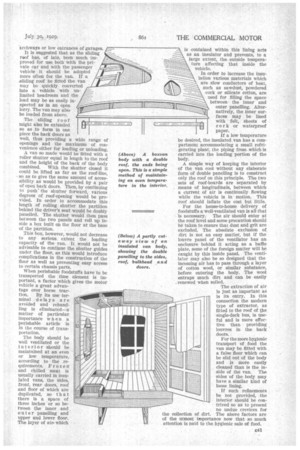SPECIALIZED EQUIPMENT
Page 62

Page 63

If you've noticed an error in this article please click here to report it so we can fix it.
for Van and Lorry Bodywork
Outlining Important Factors Which Make for Efficiency and Ensure Sound Transport Service.
MRE bodywork of a goods carrying vehicle may be improved by the adoption of constructional methods which decrease both its weight and cost, or by modifying the design so that it has a more attractive outline. During the past year or two more attention has been paid to the comfort of the driver, with the result that the cab of an open lorry is , now often fully enclosed.
In addition to these factors, which are of importance in connection with the do elopment of the various standardized types of commercial vehicle, it must not be forgotten that general utility and economy of operation are also dependent upon the extent to which each vehicle is suited for the particular kind of work on which it is engaged.
tition.
The problem of saving time and labour in loading and unloading is one which should be carefully studied, because its Eolution not only lowers running expenses, but it should also reduce street congestion when goods have to be delivered in busy thoroughfares. Improved facilities in this direction also ensure that the goods reach the customin good condition.
It is an advantage if the container system of loading can be utilized. The word " container " may be employed to describe any device whereby the repacking or rearranging of goods is avoided. The simplest form of this method of loading is the box in which the grocer puts all the items ordered by a householder. The bottle crate and pastry tray are further developments of the same idea, whilst, on a larger scale, there are various sizes of container, until the lift-van body is reached.
Large containers are often heavy and may have to be lifted by a crane. To facilitate their removal the container should, whenever possible, be designed as a hand-truck, that is, mounted on castor wheels, thereby allowing it to be run off the floor of the van direct on to the loading bay, or on to the ground, by means of a suitable ramp. If a lowloading chassis be used there is no reason why the tailboard or sides of the body should not form the ramp, the latter being lengthened, if necessary, by a hinged extension.
it is considered that, in the future, much greater use will be made of small and medium sized c o ntainers. For the smaller unit it is probable that the van or lorry will have an upper floor or platform and will be a side loader rather than that reqUiring end loading.
In order to increase the accessibility of articles which are carried in the closed type of body, plenty of headroom is often advocated. In addition to this, he fitting of side doors as well as the usual rear doors is frequently advised. The advantage of a well-lit interior is nowadays often recognized. As ordinary windows are usually obstructed by the load, the clerestory roof may be adopted, which, during the daytime, saves the cost of artificial light. van with sufficient headroom to allow a man to stand upright is often adversely criticized, because the upper part of the body is seldom used for packages and represents extra weight which is not put to the best use. A high vehicle is also the more affected by wind resistance and may be unable to negotiate low archways or low entrances of garages.
It is suggested that as the sliding roof has, of late, been much improved for use both with the private car and with the passenger vehicle it should be adopted more often for the van. If a .sliding roof be fitted the van may be quickly converted ' into a vehicle with unlimited headroom and the load may be as easily inspected as in an open lorry. The van may also be loaded from above.
The sliding roof might also be extended so as to form in one piece the back doors as well, thus providing a wide range of openings and the maximum of convenience either for loading or unloading. A van so made would be fitted with a roller shutter equal in length to the roof and the height of the back of the body combined. With the shutter closed it could be lifted as far as the roof-line, so as to give the same amount of accessibility as would be provided by a pair of open back doors. Then, by continuing to push' the shutter forward, various degrees of roof-opening would be provided. In order to accommodate this length of rolling shutter the partition behind the driver's seat would be doubly panelled. The shutter would then pass between the two panels and roll up inside a box built on the floor at the base of the partition.
This box, however, would not decrease to any serious extent the loading capacity of the van. It would not be advisable to continue the shutter guides under the floor, as this would introduce complications in the construction of the floor as well as preventing easy access to certain chassis parts.
When perishable foodstuffs have to be transported the time element is important, a factor which gives the motor vehicle a great advan tage over horse trac
tion. By its use terminal delays are avoided and rehandling is eliminated—a matter of particular importance when a perishable article is in the course of transportation.
The body should be well ventilated or the interior should be maintained at an even or low temperature, according to the requirements. Frozen and chilled meat is usually carried in insulated vans, the sides, front, rear doors, roof and floor of which are duplicated, so that there is a space of three inches or so between the inner and outer panelling and upper and lower floor. The layer of airwhich is contained within this lining acts as an insulator and prevents, to a large extent, the outside temperature affecting that inside the vehicle.
In order to increase the insulation various materials which are slow conductors of heat, such as sawdust, powdered cork or silicate cotton, are used for filling the space between the inner and outer panelling. Alternatively, the inner surfaces may be lined
1 with felt, sheets of cork or waterproof paper. If a low temperature be desired, the insulated van has a compartment accommodating a small refrigerating plant, the piping from which is carried into the loading portion of the body.
A simple way of keeping the interior of the van cool without any elaborate form of double panelling is to construct only the roof on this principle. The two sets of roof-boards are separated by means of longitudinals, between which a current of air is continually flowing while the vehicle is in motion. This roof should inflate the cost but little.
For the house-to-house delivery, of foodstuffs a well-ventilated van is all that Is necessary. The air should enter at the roof level and some precaution should be taken to ensure that dust and grit are excluded. The absolute exclusion of dirt is not an easy matter, but if the louvre panel of the ventilator has an enclosure behind it acting as a baffle plate, some of the foreign matter will be caught by this inside panel. The ventilator may also be so designed that the incoming air has to pass through a layer of cotton wool, or similar substance, before entering the body. The wool entraps much dirt and can be easily renewed when soiled.
The extraction of air is just as important as is its entry. In this connection the modern type of extractor, as fitted to the roof of the single-deck bus, is useful and is more effective than providing louvres in the back ' doors.
For the more hygienic tranS-port of food the
van may be fitted with a false floor which can be slid out of the body and is more easily cleaned than is the inside of the van. The sides of the body may have a similar kind of loose lining.
If such refinements be not provided, the interior should be con trived so as to present no undue crevices for
the collection of dirt. The above factors are of the utmost importance now that so much attention is paid to the hygienic sale of food.












































































































